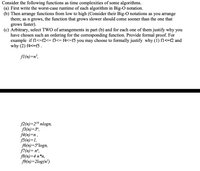
Database System Concepts
7th Edition
ISBN: 9780078022159
Author: Abraham Silberschatz Professor, Henry F. Korth, S. Sudarshan
Publisher: McGraw-Hill Education
expand_more
expand_more
format_list_bulleted
Concept explainers
Question
thumb_up100%

Transcribed Image Text:Consider the following functions as time complexities of some algorithms.
(a) First write the worst-case runtime of each algorithm in Big-O notation.
(b) Then arrange functions from low to high (Consider their Big-O notations as you arrange
them; as n grows, the function that grows slower should come sooner than the one that
grows faster).
(c) Arbitrary, select TWO of arrangements in part (b) and for each one of them justify why you
have chosen such an ordering for the corresponding function. Provide formal proof. For
example if fl<=f2<= f3<= f4<=f5 you may choose to formally justify why (1) fl<=f2 and
why (2) f4<=f5 .
fI(n)=n²,
f2(n)=210 nlogn,
f3(n)=3",
f4(n)=n,
f5(n)=1,
f6(n)=5*logn,
f7(n)= n",
f8(n)=4 n*n,
f9(n)=2log(n³)
Expert Solution
This question has been solved!
Explore an expertly crafted, step-by-step solution for a thorough understanding of key concepts.
This is a popular solution
Trending nowThis is a popular solution!
Step by stepSolved in 2 steps with 1 images

Knowledge Booster
Learn more about
Need a deep-dive on the concept behind this application? Look no further. Learn more about this topic, computer-science and related others by exploring similar questions and additional content below.Similar questions
- Consider a sequence of integers defined by the following recurrence: f(0) = 0, f(1) = 1, and f(i) = f(i – 1) + f([i/2]) for i > 2. We would like to compute f(n) using DP. If we use bottom-up approach, what is the running time? Explain how you obtained your answer. (Assume every basic operation such as plus takes O(1) time as usual.) Give a pseudo-code for a top-down approach with memoization.arrow_forwardPlease provide a correct answer with a full explanation by yourself. Don't copy. Thank you.arrow_forwardFind the running time for each of the following algorithms. Show work by finding a table of values for each while loop, writing the summations, then solving. Be sure to show work on both the upper bound and lower bound, justify the split, and check that the bounds differ by only a constant factor. Use asymptotic notation to write the answer. c) Func4(n) 1 2 3 4 567∞∞ s = 0; for i 1 to 5n do 8 j← 3i; while (j < i³) do s+ s + i - j; j+5 x j; end end 8 return (s);arrow_forward
- Given two sequences X and Y, we want to find Z i.e., the longest common subsequence (LCS) of both X and Y. Because we know that subsequences of interest are of length >= a and <= b, we threshold the LCS definition to |Z| in [a, b] (where |Z| is the sequence length). In python state the recursive formula for this problem. Implement the algorithm with bottom-up approach dynamic programming and backtracking. Create an iterative function that prints the longest common subsequence(LCS).arrow_forward4. Give an analysis of the running time (Big-Oh will do). sum = 0; for( i = 0; i < n; ++i ) for( j = 0; j < n * n; ++j ) ++sum;arrow_forwardPLEASE explain how to solve this STEP BY STEParrow_forward
- Find the running time for each of the following algorithms. Show work by finding a table of values for each while loop, writing the summations, then solving. Be sure to show work on both the upper bound and lower bound, justify the split, and check that the bounds differ by only a constant factor. Use asymptotic notation to write the answer. b) Func3(n) 1 2 3 4 5 6 7 8 9 10 11 S← 0; i+n; while (i 8) do s+ s + i - j; j← lj/⁹]; end i + 4 x i; end return (s);arrow_forwardGive the asymptotic complexity of each of the following functions in simplest terms and then order the functions by asymptotic dominance. That is, produce a permutation, f₁(n), f₂(n), such that fi(n) = O(fi+1(n)). Note if any two functions are asymptotically equivalent, i.e., if fi (n) = O(fi+1(n)). Note: 'Ig x' is a simpler notation for 'log₂ x'. fe(n)= 4 lg (n²+ 2n) + 6nº.7 f(n) = n5 + 10¹0 lg (n+100) fe(n)= 3n lg (n² + 2) + n²arrow_forwardHelp with this pleasearrow_forward
arrow_back_ios
arrow_forward_ios
Recommended textbooks for you
 Database System ConceptsComputer ScienceISBN:9780078022159Author:Abraham Silberschatz Professor, Henry F. Korth, S. SudarshanPublisher:McGraw-Hill Education
Database System ConceptsComputer ScienceISBN:9780078022159Author:Abraham Silberschatz Professor, Henry F. Korth, S. SudarshanPublisher:McGraw-Hill Education Starting Out with Python (4th Edition)Computer ScienceISBN:9780134444321Author:Tony GaddisPublisher:PEARSON
Starting Out with Python (4th Edition)Computer ScienceISBN:9780134444321Author:Tony GaddisPublisher:PEARSON Digital Fundamentals (11th Edition)Computer ScienceISBN:9780132737968Author:Thomas L. FloydPublisher:PEARSON
Digital Fundamentals (11th Edition)Computer ScienceISBN:9780132737968Author:Thomas L. FloydPublisher:PEARSON C How to Program (8th Edition)Computer ScienceISBN:9780133976892Author:Paul J. Deitel, Harvey DeitelPublisher:PEARSON
C How to Program (8th Edition)Computer ScienceISBN:9780133976892Author:Paul J. Deitel, Harvey DeitelPublisher:PEARSON Database Systems: Design, Implementation, & Manag...Computer ScienceISBN:9781337627900Author:Carlos Coronel, Steven MorrisPublisher:Cengage Learning
Database Systems: Design, Implementation, & Manag...Computer ScienceISBN:9781337627900Author:Carlos Coronel, Steven MorrisPublisher:Cengage Learning Programmable Logic ControllersComputer ScienceISBN:9780073373843Author:Frank D. PetruzellaPublisher:McGraw-Hill Education
Programmable Logic ControllersComputer ScienceISBN:9780073373843Author:Frank D. PetruzellaPublisher:McGraw-Hill Education

Database System Concepts
Computer Science
ISBN:9780078022159
Author:Abraham Silberschatz Professor, Henry F. Korth, S. Sudarshan
Publisher:McGraw-Hill Education

Starting Out with Python (4th Edition)
Computer Science
ISBN:9780134444321
Author:Tony Gaddis
Publisher:PEARSON

Digital Fundamentals (11th Edition)
Computer Science
ISBN:9780132737968
Author:Thomas L. Floyd
Publisher:PEARSON

C How to Program (8th Edition)
Computer Science
ISBN:9780133976892
Author:Paul J. Deitel, Harvey Deitel
Publisher:PEARSON

Database Systems: Design, Implementation, & Manag...
Computer Science
ISBN:9781337627900
Author:Carlos Coronel, Steven Morris
Publisher:Cengage Learning

Programmable Logic Controllers
Computer Science
ISBN:9780073373843
Author:Frank D. Petruzella
Publisher:McGraw-Hill Education